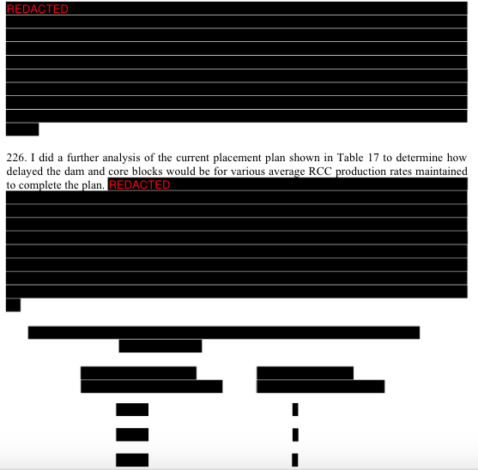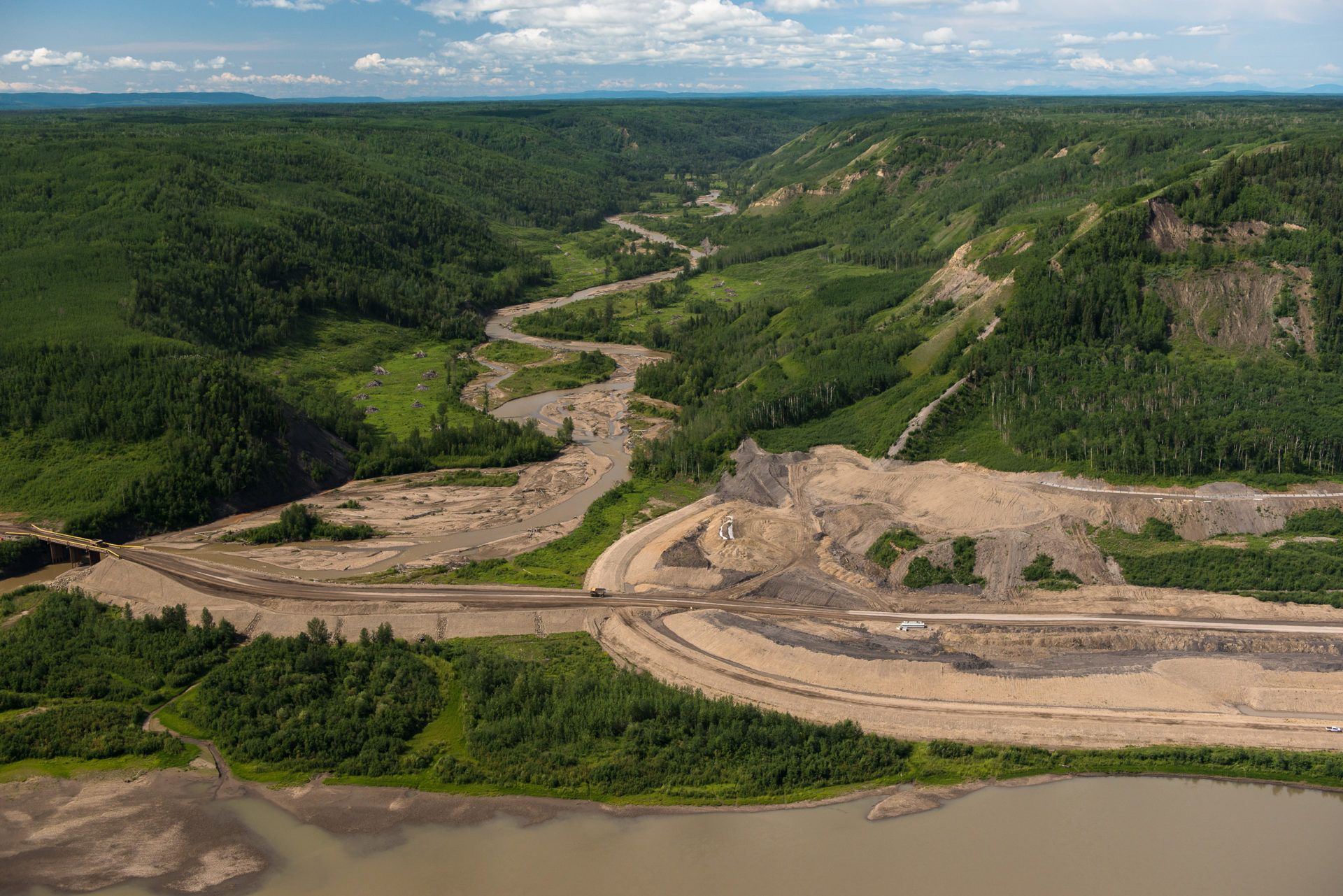
Hope for a huge, ancient and imperilled fish
First Nations are leading efforts to make sure lake sturgeon can find a home in...
BC Hydro’s troubled Site C dam project, already behind schedule and vastly over-budget, faces an “extremely high probability” of at least a one-year construction delay, according to a leading expert in large hydro dam projects.
Harvey Elwin, an expert witness in a First Nations application for an injunction to halt work on the Peace River dam, makes the statement and other revelations in a lengthy report filed late Wednesday in B.C. Supreme Court.
The report’s significant findings contradict recent public assurances from BC Hydro and B.C. Energy Minister Michelle Mungall that the $10.7 billion project is on track, implying that costs are likely to soar further.
“Traditionally, there are major risks in dam and hydroelectric projects, especially when they have complex and challenging geology and foundations like the Site C Project,” notes Elwin’s 196-page report.
Elwin, who has held major leadership roles with large multinationals working on hydroelectric projects around the world, based his report in part on confidential BC Hydro documents released on condition that some information about the Site C project not be disclosed outside the courtroom. Sections of the report are accordingly redacted.
In an affidavit filed earlier as part of his expert testimony, Elwin describes the high level of confidentiality surrounding the Site C project as “extraordinary” and says he has never encountered such secrecy during his five decades designing, developing and managing large hydroelectric projects, including during his work on China’s Three Gorges dam, the world’s largest hydro facility.

A screenshot of Elwin’s affidavit shows heavily redacted portions of the sworn document.
Elwin’s report identifies seven “major risk issues” responsible for current and future construction delays on the Site C dam, which would flood 128 kilometres of the heritage Peace River and its tributaries, forcing families from their homes and destroying Indigenous gravesites, hundreds of protected archeological sites, some of Canada’s best farmland, and habitat for more than 100 species vulnerable to extinction.
Site C is the largest publicly funded infrastructure project in B.C.’s history, with a price tag that has already ballooned from $6.6 billion to $8.8 billion and climbed by a further $1.9 billion late last year.
Premier John Horgan recently said at a media briefing that one-quarter of the project is complete.
However, information outlined in Elwin’s report contradicts that statement and raises questions about a comment from Mungall that BC Hydro is doing a “fantastic job” for British Columbians.
Among the major risks identified in Elwin’s report are “unusual” and “detrimental” delays in building the dam’s south bank drainage tunnel.*
Elwin says it should have been a relatively “straightforward, simple” job, especially compared to two large horseshoe-shaped drainage tunnels that have yet to be built three years into what was supposed to be a nine-year construction schedule.
The report also notes that excavation work on the north bank, where landslides and large tension cracks have slowed progress, is “seriously behind schedule and currently falling behind further.
Elwin’s 50-year career includes work on large dams such as the Three Gorges dam and Pakistan’s Ghazi Barotha hydroelectric project, extensive experience developing cost estimates for various aspects of large hydro projects, and long tenures at two of the world’s premiere companies that provide management and delivery of large dam and hydroelectric projects worldwide.
At the top of Elwin’s list of major risk issues for the Site C project are serious setbacks in the placement of concrete for the dam’s south bank “roller compacted concrete buttress,” a massive structure to support the powerhouse and spillways that will require almost two million cubic metres of a special blend of concrete.
Elwin points out that only about one-third of the concrete planned for 2017 was placed, noting efforts to accelerate the work have failed. At the current rate of progress, the concrete will take nine years to place instead of three, he states.
All indications are that at by end of 2017 BC Hydro and the project’s major civil works contractor “had to be aware” that the lack of progress on that work “was a major project risk,” Elwin notes.
Delays in concrete placement have ripple effects on other critical steps, leading Elwin to conclude that there is an “extremely high probability” of delays in meeting project milestones, pushing back by at least one year the diversion of the Peace River, reservoir filling and the project’s in-service date.
BC Hydro has already disclosed that the planned river diversion, which must be done before the dam structure can be built, is one year behind schedule. But the Crown corporation has stated repeatedly, and as recently as last week, that the project will be completed on time.
Elwin calls the current concrete placement timeline “overly optimistic and not realistically achievable,” noting that sustained rates for producing the concrete (the actual number of cubic metres is redacted from the report) are “unusually high.”

A screenshot of the portion of Elwin’s document where a concrete production measure is withheld from the public.
“With having to start up from a seasonal shutdown every spring and accomplish these rates of placement with the temperature restrictions and day and night temperatures for the area in combination with the logistics of these placements, the planned baseline is unrealistic,” the report says.
Elwin notes that the team working on the massive Three Gorges Dam worked for two years to get the Chinese contractor to ramp up and meet its planned peak schedule production of concrete, which set world records for concrete volumes and production rates at 400,000 cubic metres a month.
Other major Site C project risks outlined by Elwin include the river diversion tunnel excavation, main civil works work quality and non-conformance reports.
Information about the seventh major risk is redacted from Elwin’s report.
Among other disclosures, Elwin’s report reveals that only 65 hectares of 2,918 hectares in the future reservoir area have been cleared of trees and other vegetation.
The report notes that a BC Hydro Site C dam “progress report,” made public in March, says that clearing in one area called the “lower reservoir/Moberly drainage” is “substantially complete,” even though a BC Hydro affidavit filed for the First Nations court case reveals that 83 per cent of that area has yet to be cleared.

This July 2018 photos shows very little logging along the Moberly River for Site C dam construction on the Peace River. Photo: Garth Lenz / The Narwhal
Included in the internal BC Hydro documents Elwin reviewed under the confidentiality agreement are minutes from the project’s little-known Technical Advisory Board.
The Narwhal previously filed a Freedom of Information (FOI) request for all documents related to the Site C project technical advisory committee and received back information so redacted it was impossible to extract any relevant information. Even photo captions in the FOI response were redacted.
Minutes from a February 2018 meeting of the technical advisory board reviewed by Elwin describe BC Hydro’s Site C project schedule as “aspirational” and express many of the same concerns outlined by Elwin but not acknowledged by the B.C. government or BC Hydro in recent statements and the carefully-crafted Site C dam “progress” reports available to the public.
In a heavily redacted section of his report, Elwin notes that the emphasis on work quality in one section of a technical advisory board report is “unusual.”
“In my opinion, it is the sign of a large performance problem with the MCW [Major Civil Works] contractor meeting the requirements of the specifications and quality of work. In my experience, when this situation occurs it is nearly always accompanied by serious delays in the work due to quality issues involving rework or stoppages of the work until work can be done in accordance with contract requirements.”
“If the poor quality of work does not get turned around, it will continue to affect the performance and production of work and raise the likelihood of further delay and that the current Project Milestones will not be met.”
Calgary’s Petrowest Corp., one of three original partners in the $1.75 billion civil works contract, went into receivership last year. The two remaining companies in the collaboration, known as the Peace River Hydro Partners, are a wholly owned Canadian subsidiary of Spain’s Acciona S.A. and the South Korean multinational conglomerate Samsung C&T Corp.
West Moberly First Nations and Prophet River First Nation each filed civil actions in January alleging that the Site C dam and two previous Peace River dams unjustifiably infringe on their constitutionally protected treaty rights.
The question of whether the Site C project violates treaty rights has never been tested in the courts, and a favourable ruling for the Treaty 8 First Nations could terminate the project.
The nations will be in court for three weeks starting July 23 seeking an injunction to halt work on the Site C dam until their trial can be heard and a judgement is made. As an alternative, West Moberly First Nations is asking the court to consider an interim injunction suspending work in 13 areas the nation has identified as critical to preserving cultural practices guaranteed to them by Treaty 8.
West Moberly First Nations chief Roland Willson told The Narwhal he is not surprised by revelations in Elwin’s report about major risks to the Site C project and a likely delay.
“What I’m surprised by is how deep the secrecy is and how much they were hiding,” Willson said. “It’s quite shocking.”
“This project is a huge boondoggle. It’s been going sideways since the day they started the thing.”
In response to the West Moberly injunction application, BC Hydro claimed it will cost $660 million to suspend work in the critical areas for two years and $1.1 billion for a three-year suspension.
Elwin’s report demonstrates that work in the critical areas can be halted for up to 36 months without impacting any project milestones.
New problems with the Site C project have surfaced since a fast-tracked independent review last fall revealed that the project was behind schedule, over budget and plagued by geotechnical difficulties.
In May, WorkSafe BC fined Peace River Hydro Partners $310,000 for exposing workers to silica dust, which can cause lung disease and cancer.
Also in May, the B.C. Environmental Assessment Office issued an order to BC Hydro to control runoff water, soil erosion and sediment on the dam construction site, after BC Hydro failed to comply with a previous order to put a plan into place.
B.C. does not need power from the Site C project and the NDP government has said electricity from the Site C dam will be sold on the spot market for less than it costs to produce, leaving BC Hydro customers to make up the difference.
2018-07-18 FILED Affidavit #1 Elwin Site C Hearing by The Narwhal on Scribd
*Update July 19, 2017 8:24am pst. This article previously stated the south bank drainage tunnel was identified as “one of the most important features of the Site C project” in Elwin’s report. However it was the right bank RCC buttress that Elwin identified as such, and not the south bank drainage tunnel. An update has been made to reflect this fact.
Get the inside scoop on The Narwhal’s environment and climate reporting by signing up for our free newsletter. Angello Johnson’s shoulders burn, and his arms...
Continue reading
First Nations are leading efforts to make sure lake sturgeon can find a home in...

We’re excited to share that an investigation by The Narwhal is a finalist for the...

A new documentary, Nechako: It Will Be a Big River Again, dives into how two...
